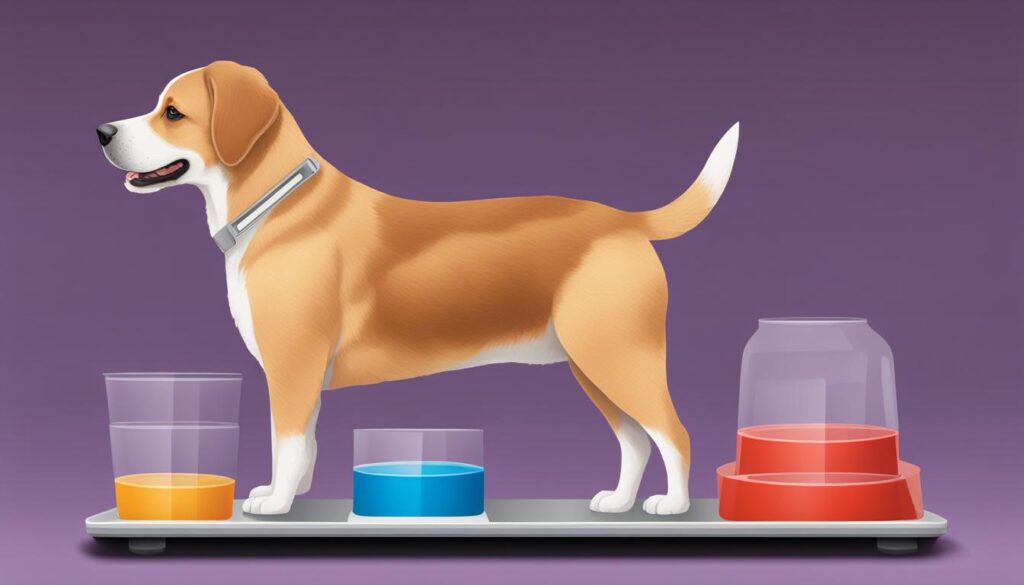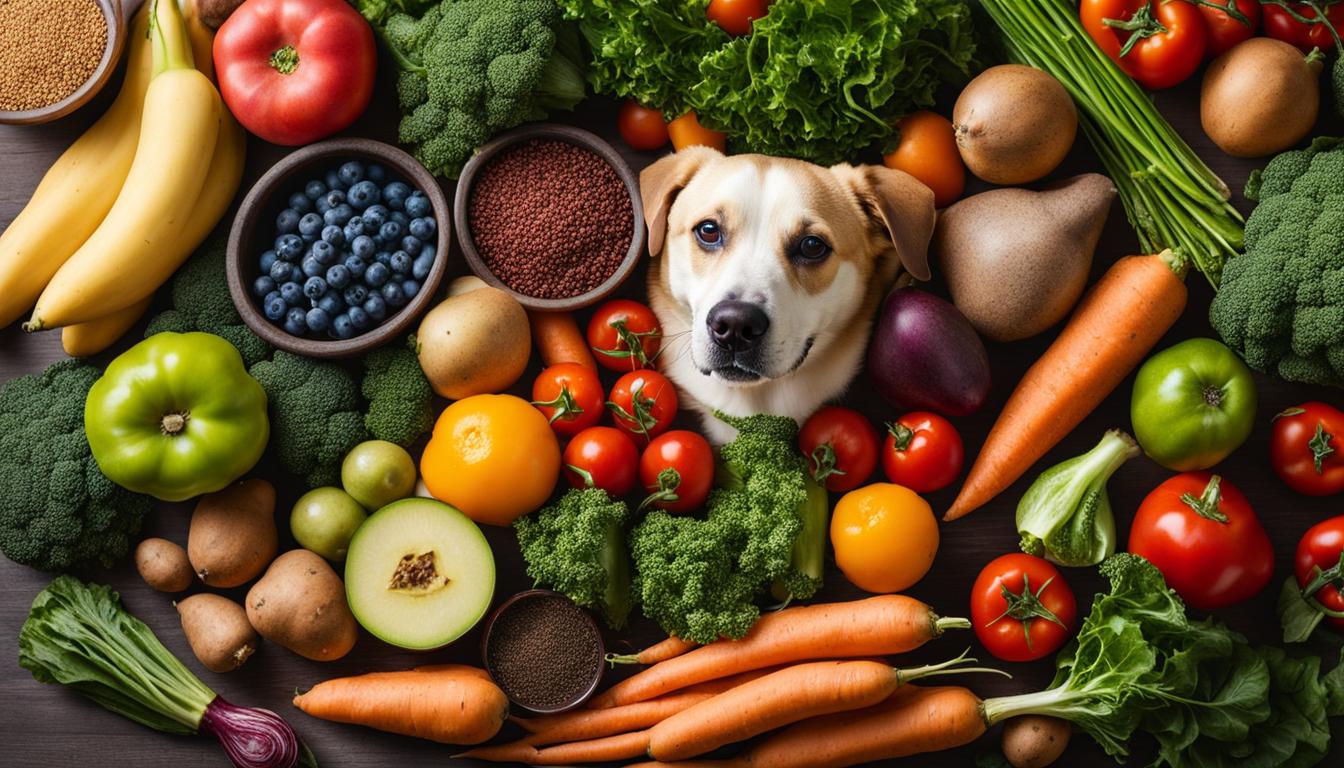Helping your dog lose weight is crucial for their overall health and longevity. Just like humans, being overweight can lead to various medical conditions in dogs, including diabetes, heart disease, and arthritis. That’s why it’s important to work with your veterinarian to develop an effective weight loss program that suits your dog’s individual needs and any underlying medical conditions they may have.
So, if you’re worried about your furry friend’s weight and want to help them shed those extra pounds, you’ve come to the right place. In this article, we’ll explore the importance of weight loss for dogs and how to get started on a successful weight loss journey. Let’s dive in!
Key Takeaways:
- Being overweight can lead to various health issues in dogs, just like in humans.
- A tailored weight loss program developed with your veterinarian is essential.
- Weight loss can improve your dog’s overall health and increase their energy levels.
- Consulting with a professional ensures you’re making the best choices for your dog’s unique situation.
- Regular veterinary check-ups and ongoing support are crucial in maintaining a healthy weight.
Why Should My Dog Lose Weight?
Carrying excess weight can significantly impact your dog’s health. Obesity in dogs puts them at risk for various health conditions, including type 2 diabetes, heart disease, osteoarthritis, joint injuries, high blood pressure, and certain forms of cancer. Overweight and obese dogs tend to have shorter lifespans and may be less active and playful compared to dogs at a healthy weight. It’s important to be aware of the consequences of obesity in dogs and take action to help your furry friend achieve a healthier weight.
On the other hand, weight loss in dogs can bring about numerous health benefits. Shedding those extra pounds can improve overall health, increase energy levels, and potentially prolong your dog’s lifespan. With weight loss, your dog may experience improved mobility, reduced joint pain, and a decreased risk of obesity-related diseases. Additionally, maintaining a healthy weight can enhance their quality of life and overall well-being.
It’s essential to remember that every dog is unique, and weight loss programs should be tailored to their specific needs and circumstances. Consulting with your veterinarian is crucial in developing an effective weight loss plan that takes into account your dog’s individual requirements, any underlying medical conditions, and dietary restrictions.

“Weight loss in dogs can improve overall health, increase energy levels, and potentially prolong your dog’s lifespan.”
How to Begin a Weight Loss Program for Your Dog
When it comes to helping your dog lose weight, it’s important to start with a solid plan. This begins by consulting with your veterinarian for guidance and assistance. Veterinary assistance is crucial in developing a weight loss program that is safe and effective for your furry friend. During this consultation, your veterinarian will assess your dog’s overall health, check for any underlying medical conditions that may contribute to weight gain, and determine their ideal weight.
Underlying medical conditions, such as hypothyroidism or Cushing’s disease, can impact your dog’s ability to lose weight. These conditions need to be addressed as part of the weight loss program. Your veterinarian may recommend a specific weight loss diet tailored to your dog’s needs. The right weight loss diet will help your dog shed pounds while still providing the necessary nutrients for their overall health and well-being.
Embarking on a weight loss program for your dog requires consistency and commitment. It’s important to follow your veterinarian’s recommendations regarding portion control and feeding schedule. Regular check-ins with your veterinarian will allow them to monitor your dog’s progress and make any necessary adjustments to the weight loss program.
The Importance of Veterinary Assistance for Weight Loss Program
“Consulting with your veterinarian is crucial when starting a weight loss program for your dog. They have the expertise and knowledge to provide the right guidance and support throughout the process. Your veterinarian will consider your dog’s unique needs and any underlying medical conditions to develop a safe and effective weight loss program. They can also provide valuable advice on portion control, feeding schedule, and exercise recommendations for optimal results.”
Weight Loss Diet: Key Considerations for Your Dog
Choosing the right weight loss diet for your dog is essential for their success in shedding those extra pounds. Your veterinarian will take into account factors such as your dog’s breed, size, age, and activity level when recommending a weight loss diet. The diet will aim to provide balanced nutrition while promoting weight loss.
Weight loss diets for dogs often prioritize high-quality protein sources and limit carbohydrates. This approach helps to maintain muscle mass while reducing fat. Some weight loss diets may also include added fiber to promote satiety and prevent begging for food. It’s important to follow the feeding guidelines provided by your veterinarian and avoid supplementing with additional treats or table scraps, as they can hinder weight loss progress.
Remember, every dog is unique, and their weight loss journey will require personalized attention. With the right veterinary assistance and a well-designed weight loss program, you can help your dog achieve a healthier weight and improve their overall well-being.
| Benefits of Veterinary Assistance for Weight Loss Program: | Benefits of a Weight Loss Diet: |
|---|---|
| Expert guidance and support | Promotes weight loss while maintaining muscle mass |
| Addressing underlying medical conditions | Provides balanced nutrition |
| Personalized recommendations | Prevents begging for food |
| Monitoring progress and making adjustments | Improves overall well-being |

How to Determine the Right Amount to Feed Your Dog
When it comes to helping your overweight dog achieve their ideal weight, proper portion management is key. Determining the right amount to feed your dog involves calculating their ideal weight, considering their calorie requirements, and addressing any specific dietary restrictions or recommendations from your veterinarian.
To start, your veterinarian will calculate your dog’s ideal weight based on their breed and size. This serves as a target weight for your pup to work towards. Depending on the extent of their excess weight, your veterinarian may recommend a target weight higher than their ideal weight to begin with.
In terms of the weight loss program, a safe weight loss rate for most dogs is 3-5% of their body weight per month. This gradual approach helps ensure that the weight loss is sustainable and that your dog is not experiencing any adverse effects from rapid weight loss.
Portion Calculation Example:
| Dog’s Ideal Weight: | 50 pounds |
|---|---|
| Calorie Requirement: | 800 calories/day |
| Weight Loss Goal: | 5% of body weight per month |
| Monthly Weight Loss: | 2.5 pounds |
| Daily Calorie Deficit: | 83 calories/day |
| Adjusted Calorie Intake: | 717 calories/day |
Based on these calculations, your dog’s adjusted calorie intake should be around 717 calories per day to achieve a safe and steady weight loss of 2.5 pounds per month. It’s important to note that these calculations are just an example, and your veterinarian will provide you with specific recommendations tailored to your dog’s needs.
Remember, portion management is crucial in ensuring your dog’s weight loss success. It’s essential to follow your veterinarian’s guidance and monitor your dog’s progress closely to make any necessary adjustments along the way.

What Makes Veterinary Weight Loss Diets Special?
Veterinary weight loss diets are specifically designed to address the unique needs of overweight dogs. These specialized diets provide a balanced and nutritious approach to weight loss, helping your dog shed those extra pounds while ensuring they still receive the essential nutrients they need for optimal health.
One type of weight loss diet option is the high protein low carb diet. These diets prioritize lean sources of protein, such as chicken or fish, which help to maintain muscle mass while promoting weight loss. By reducing the intake of carbohydrates, these diets can also help regulate blood sugar levels and prevent energy crashes.
Fiber-rich diets are another effective option for weight loss. These diets are packed with fiber from sources like vegetables and whole grains. The high fiber content helps your dog feel fuller for longer, reducing their hunger and preventing overeating. Additionally, fiber aids in digestion and can help regulate bowel movements.
For dogs with specific metabolic conditions or stubborn weight issues, metabolic diets may be recommended. These diets are carefully formulated to boost metabolism and calorie burning, helping your dog overcome any metabolic challenges they may have and achieve their weight loss goals.
Table: Weight Loss Diet Options
| Diet Type | Description |
|---|---|
| High Protein Low Carb Diets | These diets prioritize lean sources of protein and limit carbohydrates, promoting weight loss while maintaining muscle mass. |
| Fiber-Rich Diets | These diets are high in fiber, helping your dog feel full and satisfied while aiding digestion and regulating bowel movements. |
| Metabolic Diets | Specifically formulated to address metabolic conditions, these diets enhance metabolism and calorie burning to support weight loss. |
Introducing the New Diet to Your Dog
Transitioning your dog to a new weight loss diet requires a gradual approach to avoid digestive upsets. It’s important to remember that dogs may be resistant to change, so patience and persistence are key. Here are some essential diet change tips to help make the transition smoother:
- Gradual Transition: Start by mixing a small amount of the new diet with your dog’s current food. Begin with a 75% old diet and 25% new diet ratio, and gradually increase the ratio of the new diet over the course of about a week.
- Monitor Your Dog’s Reaction: Observe your dog’s response to the new diet. Check for any signs of digestive upset, such as diarrhea or vomiting. If you notice any severe symptoms, consult your veterinarian.
- Enhance Palatability: Some dogs may need extra encouragement to accept the new diet. You can enhance the palatability by warming the food slightly or adding a small amount of flavoring, such as salmon juice or low-fat broth. However, it’s important not to add excessive flavorings that could lead to overeating.
Remember, each dog is unique, and their taste preferences may vary. If your dog remains hesitant to transition, consult with your veterinarian for additional guidance and alternative strategies.
“The key to a successful diet transition is patience. Gradual changes and monitoring your dog’s response are crucial in ensuring a smooth transition to a new diet.”
Once your dog has fully transitioned to the new diet, continue to monitor their progress and consult with your veterinarian regularly. Adjustments may be necessary as your dog’s weight loss journey progresses. Providing ongoing support, guidance, and veterinary assistance will help maintain a healthy weight for your furry friend.
Incorporating Exercise into Your Dog’s Weight Loss Program
Exercise is a crucial component of your dog’s weight loss program. Not only does it help in burning calories, but it also promotes overall fitness and well-being. Regular physical activity can aid in shedding those extra pounds and improve your dog’s quality of life. Here are some effective ways to incorporate exercise into your dog’s weight loss program:
1. Daily Walks
One of the simplest and most accessible forms of exercise for your dog is a daily walk. Aim for a brisk 30-minute walk each day to get your dog moving and burning calories. Walking not only helps in weight loss but also provides mental stimulation and a chance for your dog to explore their surroundings. Make sure to adjust the pace and duration of the walk based on your dog’s fitness level and any underlying medical conditions.
2. Interactive Toys and Games
Engaging your dog in interactive toys and games can be a fun way to incorporate exercise into their weight loss program. Toys such as puzzle feeders or treat-dispensing toys require physical effort and mental focus, which helps burn calories. You can also play games like fetch or hide-and-seek to get your dog moving and active. Experiment with different toys and games to find what interests your dog the most.
3. Swimming
If your dog enjoys being in the water, swimming can be an excellent low-impact exercise for weight loss. Swimming engages various muscle groups and provides an effective cardiovascular workout. It is particularly beneficial for overweight dogs or those with joint issues as it puts less stress on their joints. If you’re introducing your dog to swimming, start in a shallow area and gradually increase the depth as they become more comfortable.
Remember, consistency is key when it comes to exercise. Set a routine and stick to it, gradually increasing the intensity and duration as your dog’s fitness level improves. Always monitor your dog during exercise to ensure they are not overexerting themselves. If you have any concerns about your dog’s exercise regimen, consult with your veterinarian for guidance.
Regular physical activity can aid in shedding those extra pounds and improve your dog’s quality of life.
Conclusion
Helping your dog achieve a healthy weight is essential for their overall health and longevity. Obesity in dogs is a widespread problem that can lead to various health complications. By working closely with your veterinarian and implementing a tailored weight loss program, you can improve your dog’s quality of life, reduce the risk of obesity-related diseases, and potentially extend their lifespan.
Maintaining a healthy weight is not just about appearance; it’s about the overall well-being of your furry friend. Dogs that are overweight or obese face a higher risk of developing conditions such as diabetes, heart disease, osteoarthritis, and certain forms of cancer. By helping your dog shed those extra pounds, you can significantly reduce the likelihood of them encountering these health issues.
The importance of veterinary guidance cannot be overstated when it comes to managing your dog’s weight. Veterinarians have the expertise to evaluate your dog’s specific situation, consider any underlying medical conditions, and recommend the most suitable weight loss program and diet. Regular veterinary check-ups and ongoing support are essential in maintaining a healthy weight for your dog.
Remember, every dog is unique, and what works for one may not work for another. That’s why it’s crucial to consult with a professional to develop the best weight loss plan for your furry friend. By taking the necessary steps to help your dog achieve a healthy weight, you are not only improving their quality of life but also increasing their chances of living a longer, happier, and healthier life.
FAQ
Why is it important for my dog to lose weight?
Being overweight can contribute to various medical conditions such as diabetes, heart disease, and arthritis. It’s essential for your dog’s overall health and longevity.
What health risks are associated with obesity in dogs?
Carrying excess weight can lead to conditions such as type 2 diabetes, heart disease, osteoarthritis, joint injuries, high blood pressure, and certain forms of cancer. It can also shorten your dog’s lifespan and reduce their activity levels.
How should I begin a weight loss program for my dog?
It’s important to consult with your veterinarian to assess your dog’s overall health and any underlying medical conditions. They can recommend a weight loss diet tailored to your dog’s needs.
How do I determine the right amount to feed my dog?
Your veterinarian will calculate your dog’s ideal weight and consider their calorie requirements to determine the appropriate amount of food to feed. Portion management is crucial for weight loss.
What makes veterinary weight loss diets special?
Veterinary weight loss diets are specifically formulated to support healthy weight loss in dogs. They may vary in composition, with some diets being high in protein and low in carbohydrates, while others are high in fiber to promote satiety.
How do I introduce the new diet to my dog?
It’s important to transition your dog to a new diet gradually over the course of about a week to minimize digestive upsets. Mixing a small amount of the new diet with their current food and gradually increasing the ratio is recommended.
How can I incorporate exercise into my dog’s weight loss program?
Increasing the intensity and duration of daily walks, incorporating interactive toys or games of fetch, and providing regular exercise can promote calorie burning and weight loss while improving overall fitness and well-being.
Why is veterinary guidance important in a dog’s weight loss journey?
Working closely with your veterinarian ensures that your dog’s weight loss program is tailored to their specific needs. Regular check-ups and ongoing support help maintain a healthy weight and overall well-being for your dog.





